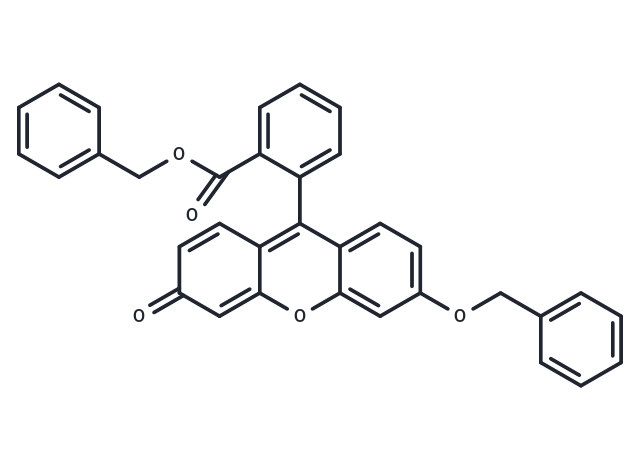Shopping Cart
Remove All Your shopping cart is currently empty
Your shopping cart is currently empty
Dibenzylfluorescein (DBF), a fluorogenic probe (Fluorescent dye), serves as a substrate for various cytochrome P450 (CYP) isoforms, such as CYP3A4, CYP2C8, CYP2C9, CYP2C19, and aromatase (CYP19). It is commonly utilized at its K_m value range of 0.87-1.9 µM (Ex=485nm, Em=535nm) to monitor alterations in CYP enzymatic activity attributable to pharmaceutical interventions or pathophysiological conditions [1] [2] [3] [4].

| Pack Size | Price | USA Warehouse | Global Warehouse | Quantity |
|---|---|---|---|---|
| 1 mg | $159 | 35 days | 35 days | |
| 5 mg | $623 | 35 days | 35 days | |
| 10 mg | $1,130 | 35 days | 35 days | |
| 25 mg | $2,500 | 35 days | 35 days |
| Description | Dibenzylfluorescein (DBF), a fluorogenic probe (Fluorescent dye), serves as a substrate for various cytochrome P450 (CYP) isoforms, such as CYP3A4, CYP2C8, CYP2C9, CYP2C19, and aromatase (CYP19). It is commonly utilized at its K_m value range of 0.87-1.9 µM (Ex=485nm, Em=535nm) to monitor alterations in CYP enzymatic activity attributable to pharmaceutical interventions or pathophysiological conditions [1] [2] [3] [4]. |
| In vitro | P450-Catalyzed Metabolism of Dibenzylfluorescein and the Influence of Alkali Experimental Method [3]: During the reaction, P450 enzymes debenzylate Dibenzylfluorescein to yield fluorescent fluorescein benzyl ester, which can be hydrolyzed to fluorescein in the presence of sodium hydroxide. The addition of 2M sodium hydroxide also results in the decomposition of Dibenzylfluorescein into fluorescein benzyl ether. The conditions for CYP2C19 enzyme activity and inhibition experiments include a 150 μL reaction mixture containing 0.1M Tris-HCl buffer (pH 7.4), 10 μM Dibenzylfluorescein, 15 pmol CYP2C19, and 50 μL NADPH regenerating system. The NADPH regenerating system comprises 1.13 mM NADP, 12.5 mM citric acid, 56.33 mM KCl, 187.5 mM Tris-HCl (pH 7.4), 12.5 mM MgCl2, 0.0125 mM MnCl2, and 0.075 U/ml citrate dehydrogenase. Samples are incubated at 37°C for 30-60 minutes, rapidly cooled to 4°C to stop the reaction, centrifuged, and the supernatant is analyzed by LC-MS. Analyses are carried out using pure Dibenzylfluorescein, fluorescein benzyl ester, fluorescein benzyl ether, and fluorescein (all at 10 μM) as standards, both in the absence and presence of 2 M NaOH. |
| Synonyms | DBF |
| Molecular Weight | 512.55 |
| Formula | C34H24O5 |
| Cas No. | 97744-44-0 |
| Smiles | O=C(OCc1ccccc1)c1ccccc1-c1c2ccc(OCc3ccccc3)cc2oc2cc(=O)ccc12 |
| Storage | keep away from direct sunlight | Powder: -20°C for 3 years | In solvent: -80°C for 1 year | Shipping with blue ice/Shipping at ambient temperature. |
| Size | Quantity | Unit Price | Amount | Operation |
|---|

Copyright © 2015-2026 TargetMol Chemicals Inc. All Rights Reserved.